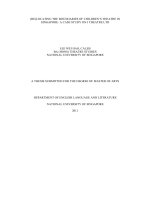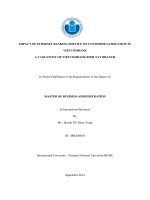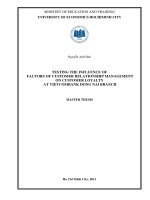Impact of internet service on customer satisfaction in vietcombank a case study of vietcombank binh tay branch
Bạn đang xem bản rút gọn của tài liệu. Xem và tải ngay bản đầy đủ của tài liệu tại đây (1.19 MB, 81 trang )
IMPACT OF INTERNET BANKING SERVICE ON CUSTOMER SATISFATION IN
VIETCOMBANK
A CASE STUDY OF VIETCOMBANK BINH TAY BRANCH
In Partial Fulfillment of the Requirements of the Degree of
MASTER OF BUSINESS ADMINISTRATION
In International Business
By
Ms : Huynh Thi Diem Trang
ID : MBA06038
International University - Vietnam National University HCMC
September 2014
IMPACT OF INTERNET BANKING SERVICE ON CUSTOMER SATISFATION IN
VIETCOMBANK
A CASE STUDY OF VIETCOMBANK BINH TAY BRANCH
In Partial Fulfillment of the Requirements of the Degree of
MASTER OF BUSINESS ADMINISTRATION
in International Business
By
Ms : Huynh Thi Diem Trang
ID : MBA06038
International University - Vietnam National University HCMC
September 2014
Under the guidance and approval of the committee, and approved by all its members, this
thesis has been accepted in partial fulfillment of the requirements for the degree.
Approved:
---------------------------------------------Chairperson
---------------------------------------------Committee member
---------------------------------------------Committee member
--------------------------------------------Committee member
--------------------------------------------Committee member
--------------------------------------------Committee member
Acknowledgment
First and foremost, I would like to express my deepest thanks to my advisor –
PhD. Le Van Chon for his support and guidance throughout my thesis writing. I am
sure it would have not been possible without his help.
Secondly, I would like to send my sincere appreciation to professors and lecturers
in Master course – International University for teaching and training me during 2
years which provided to me a lot of precious knowledge.
Thirdly, I am grateful to all customers of Vietcombank who provided valuable
data during my survey. If there is no input data they contributed, the thesis can’t be
completed today.
Last but not least, I would like to express my sincere thanks to my parents for
their unceasing encouragement and support me during my hard working time on this
thesis.
i
Plagiarism Statements
I would like to declare that, apart from the acknowledged references, this
thesis either does not use language, ideas, or other original material from anyone; or
has not been previously submitted to any other educational and research programs or
institutions. I fully understand that any writings in this thesis contradicted to the
above statement will automatically lead to the rejection from the MBA program at the
International University – Vietnam National University Ho Chi Minh City.
ii
Copyright Statement
This copy of the thesis has been supplied on condition that anyone who
consults it is understood to recognize that its copyright rests with its author and that
no quotation from the thesis and no information derived from it may be published
without the author’s prior consent.
© Huynh Thi Diem Trang / MBA06038 / 2012-2014
iii
Table of Contents
List of Tables ..................................................................................................................... vi
List of Figures ................................................................................................................... vii
Abstract ............................................................................................................................ viii
Chapter one – Introduction ..................................................................................................1
1. Background ........................................................................................................1
2. Rationale for the study .......................................................................................3
3. Problem Statement .............................................................................................3
4. Objectives ...........................................................................................................4
5. Research Questions ............................................................................................4
6. Scope of the study ..............................................................................................5
7. Structure of the study .........................................................................................5
Chapter two – Literature Review .........................................................................................6
1. Basic Concepts ...................................................................................................6
1.1. Customer Satisfacion (CS) .....................................................................6
1.2. Service Quality .......................................................................................7
1.3. Internet Banking .....................................................................................9
1.4. Relationship between Service Quality and Customer Satisfacion .......12
2. Empirical Studies .............................................................................................14
3. Suggested Conceptual Model ...........................................................................17
Chapter three – Methodology ............................................................................................21
1. Sampling techniques and Sample size..............................................................21
2. Research Instrument .........................................................................................21
3. Data Collection Procedures ..............................................................................22
3.1. Primary Data .......................................................................................22
3.2. Secondary Data ...................................................................................23
4. Data analysis.....................................................................................................23
Chapter Four – Data Analysis and Results ........................................................................26
1. About Vietcombank Binh Tay Branch .............................................................26
2. Sample Demographics ......................................................................................31
iv
3. Assessing scale and research model .................................................................35
3.1. Assessing scale reliability by Cronbach’s Alpha ................................35
3.2. Descriptive Statistic ............................................................................40
3.3. Exploratory Factor Analysis (EFA) ....................................................44
3.4. Correlations between variables ...........................................................48
3.5. Hypotheses testing ..............................................................................50
3.6. Linear Regression Equation ................................................................52
3.7. Anova Analysis ...................................................................................53
Chapter Five – Conclusion and Recommendations ...........................................................55
References ..........................................................................................................................58
Appendix ............................................................................................................................62
v
List of Tables
Table 1. List of previous studies ...................................................................................... 14
Table 2. Independent variables (indicators) .................................................................... 24
Table 3. Total revenue of VCB Binh Tay from 2009-1st half 2012 .............................. 28
Table 4. Total number of new I-Banking users of VCB Binh Tay from 2011-2013 ......... 29
Table 5. Respondent Characteristics ............................................................................... 30
Table 6. Cronbach’s Alpha of independent variables scales ........................................... 36
Table 7. Cronbach’s Alpha after rejecting CS4 item ....................................................... 38
Table 8. Cronbach’s Alpha after rejecting CS6 item....................................................... 39
Table 9. Descriptive Statistics.......................................................................................... 41
Table 10. KMO and Bartlett's Test .................................................................................. 44
Table 11. Exploratory Factor Analysis (EFA) Results .................................................... 45
Table 12. Total Variance Explained ................................................................................ 46
Table 13. Correlations ..................................................................................................... 48
Table 14. Coefficients ...................................................................................................... 51
Table 15. Model Summary ............................................................................................... 53
Table 16. ANOVAb ........................................................................................................... 54
vi
List of Figures
Figure 1. Conceptual Model ........................................................................................ 19
Figure 2. Organization Structure of VCB Binh Tay ....................................................... 27
Figure 3: Total revenue of VCB Binh Tay from 2009 to1st half 2012 ........................... 29
Figure 4: Total number of new I-Banking users of VCB Binh Tay from 2011-2013 ... 30
Figure 5: Age ranges ....................................................................................................... 33
Figure 6. Income ranges ................................................................................................. 34
vii
Abstract
The purpose of this study is to explore the internet banking service dimensions
that will have the impact on customer satisfaction of Vietcombank customers.
A quantitative research is applied with survey questionnaires distributed to
respondents at bank counters.There are eventually 211 responses that are used as input
data. Collected data are processed in the statistical software SPSS; the consistency
cofficients measured with cronbach’s Alpha for scaling test and Exploratory Factor
Analysis (EFA) were used.
Results show that Web design, Customer service, Assurance, Preferential
Treatment and Information Provision are the important factors that have the impact on
customer satisfaction. While Assurance is the most significant factor, followed by
Customer service, Preferential treatment, Information Provision and Web design
respectively.
It is found that, generally, customer satisfaction is not too high, just above
average. The
findings suggest that banks should focus on main factors, especially
Assurance, in specific plans to develop services and enhance quality for higher
satisfaction of customers from this service.
Keywords : Customer Satisfaction, Internet Banking Service.
viii
CHAPTER ONE - INTRODUCTION
1. Background
In today’s world of intense competition, one of the keys to competitive
advantage is delivering high quality services and enhancing customer satisfaction
(Ismail, Made and Francis, 2009; Shemwell, Yavas and Bilgin, 1998). Service
quality has been identified as the ultimate goal of service providers
(Sureshchandar, Rajendran and Anantharaman, 2002). Service quality and
customer satisfaction are inarguably two concepts at the crux of the marketing
theory and practice (Spreng and Mackoy, 1996). Today, many financial service
organizations are rushing to become more customer focused (Peppard, 2000).
Technological
developments
particularly
in
the
area
of
telecommunications and information technology are revolutionizing the banking
industry. The internet has been exploited as a means to provide e-services. Many
banks try to provide a quality online service to satisfy their customers. These
banks are introducing internet banking as an assurance to their customers that they
will be able to maintain a competitive quality of service in the future, in efforts to
avoid losing their customers (Rod et al. 2009). Offering internet banking is no
longer regarded as a competitive advantage but a competitive necessity (Gan et
al., 2006, as cited in Rod et al. 2009). With the popularity of computers, easy
access to Internet and World Wide Web (WWW), Internet is increasingly used by
banks as a channel for receiving instructions and delivering their products and
services to their customers.
-1-
Stiff competition in banking sector is forcing the banks to become
customer friendly and customer oriented. Thus the customer satisfaction has
become more important with the increasing competition.
The modern banking has become customer-driven and technology-driven.
Driven by the challenges of competition, rising customer expectations and
shrinking margins, banks have been using technology to reduce cost and enhance
efficiency, productivity and customer convergence. Technology-intensive
delivery channels, like Automated Teller Machines (ATMs), internet banking,
tele-banking and mobile banking etc., have created a win-win situation by
extending greater convenience and multiple options for customers while
providing tremendous cost advantages to the banks (Shainesh and Choudhary,
2004).
During the last decade, technology has been dramatically transforming the
banking activities in Vietnam. The banking sector in Vietnam has witnessed
intensive competition in recent years. Since becoming a member of the World
Trade Organization (WTO) in 2007, the government has been carrying out the
commitments of trade liberalization policies, which has encouraged some
international banks and private sector institutions to intensify their activities in the
banking sector. Customers are also increasingly becoming sophisticated as they
have access to the latest forms of delivery channels (such as the ATM, internet
banking, etc.). Consequently, many financial institutions have to focus on
increasing customer satisfaction and customer retention through improved quality
of their services.
-2-
The rapid growth of internet banking in recent years is a clear indication
of consumer acceptance of this media. However, the impact of internet banking
on customer satisfaction in Vietnam is yet to be examined as few studies have
addressed this issue. This study thus aims to fill the gap in the literature by
focusing on the impact of internet banking service quality on customer
satisfaction with a case study of Joint Stock Commercial Bank for Foreign Trade
of Vietnam (Vietcombank) at Binh Tay Branch.
2.
Rationale for the study
The aim of this research is to study the level of customer satisfaction about
the quality of Vietcombank online banking services to identify whether customers
intend to revisit the banking site and to maintain a lasting relationship with it or
not.
From a theoretical viewpoint, this research enriches the literature that has
explored the concept of perceived quality of online services.
From a managerial point of view, it points to the bankers the importance
of promoting satisfaction factors which could produce favorable behavioral
intentions among customers.
3.
Problem statement
Although there has been a rapid diffusion of new technology applications
in banking sector in Vietnam, internet banking services have not been widely
adopted by bank customers. This may be due to lack of trust, poor customer’s
attitude and perceived risk towards the services.
-3-
When judging the quality of the provided internet banking service,
customers consider a lot of factors which influence their judgment. For some
customers the response and efficiency of the service providers would be of
greatest importance, for others the security and privacy issues might be more
important, and still for others what matters most may be the website design and
ease of use. In reality, customers have different expectations and requirements.
4.
Objectives
The study aims at enriching the knowledge and understanding of factors affecting
customer satisfaction of internet banking service in Vietcombank. Specifically,
the main objectives of the study are:
-
To identify what main factors of internet banking service impact customer
satisfaction.
-
To evaluate the extent of their impacts on customer satisfaction about internet
banking service quality
-
To identify the level of satisfaction of customers towards Vietcombank
internet banking service.
5.
Research Questions:
In order to achieve those 3 objectives, this study aims to answer the following
research questions:
1. What are the major factors affecting to customer satisfaction in using
internet banking service?
2. How do these factors impact customer satisfaction in internet banking
service quality?
-4-
3. What is the level of customer satisfaction towards the quality of
Vietcombank online banking service?
6. Scope of the study
The study concentrates on customer attitude and their satisfaction level of
using internet banking services provided by Vietcombank.
Due to time, resource constraints, the author could not carry out the survey
in all branches of Vietcombank countrywide, so that the study is limited to
Vietcombank - Binh Tay Branch located in district 6, Ho Chi Minh City.
7. Structure of the study
This study is organized into five chapters. The Introduction, which is
Chapter One, consists the background of the study, rationale, statement of the
problem, the main and specific objectives of the study, research questions and
how the study is organized. Chapter Two discusses literature related to the study
and introduces the framework while research methodology is discussed in chapter
Three. Chapter Fourth presents the data and analysis. Finally, Chapter Five
presents the summary of findings, conclusions and provide recommendations.
-5-
CHAPTER TWO - LITERATURE REVIEW
1.
Basic Concepts
1.1.Customer Satisfaction (CS)
Customer satisfaction (CS) has received numerous attention and interest
among scholars and practitioners alike because of its role as an important
variable of business strategy in this very competitive market (Lovelock and
Wirtz, 2007). Since the early 1960’s to date several researches have been
conducted on customer satisfaction by different researchers. Infact in the
words of Parker and Mathews “customer satisfaction has been fundamental to
the marketing concept for over three decades” (Parker and Mathews, 2001).
Customer satisfaction has been traditionally defined as “an evaluative
judgment prior to making a choice, about any particular purchase decision”
(Oliver, 1980). Pairot (2008) also defined Customer satisfaction as the
company's ability to fulfill the business, emotional, and psychological needs
of its customers. In that definition he acknowledged that customers usually
have varied levels of satisfaction since they have different attitudes and
experiences as perceived from the company.
According to Churchill and Surprenant (1982), customer satisfaction can
be defined as a “disconfirmation paradigm” since it is a result of
confirmation/disconfirmation of expectation that evaluates a product’s
performance with it expectation and desire. Customer satisfaction is therefore
an attitude or a rating made by the customer by comparing their pre-purchase
-6-
expectation to their subjective perceptions of actual performance (Oliver,
1980). ‘‘Satisfaction is a person’s feeling of pleasure or disappointment
resulting from comparing a product’s performance (outcome) in relation to his
or her expectation’’ (Kotler & Keller, 2006 p. 144). Bank customer
satisfaction is regarded as banks fully meeting the customers’ expectation
(Bloemer, Ruyter, and Peeters, 1998) and also said to be a feeling or attitude
formed by bank customers after service, which expressly connects the various
purchasing behaviour (Jamal and Naser, 2002).
Customer satisfaction is seen to be a state of mind that customers have
about a company when their expectations have been met or exceeded over the
lifetime of the product or service (Kevin Cacioppo, 1995 and Kumbhar,
2010). Satisfaction appears to be between pre-exposure and post-exposure of
attitudinal components (Oliver, 1980) and serves as a link between the various
stages of consumer buying behavior (Jamal and Nasser, 2002). Lenka, Suar et
al. (2009, p. 50) identified ‘customers’ satisfaction as a combination of their
cognitive and affective response to service encounters’.
1.2. Service Quality
Parasuraman, Zeithaml, and Berry (1985) posit that service quality is
‘performance based’ rather than object oriented, therefore “precise
manufacturing specifications concerning uniform quality can rarely be set”.
Tapiero (1996) also indicates that the definition of the term quality differ from
author to author and it is usually based on the person making the definition,
the measures applied and the context within which it is considered.
-7-
Service quality is an important contemporary issue in service management
and marketing (Clottey and Collier, 2008). Banking is seen as a service that
captures all the characteristics of service (Chakrabarty, 2006). Literatures
sampled from the 1980’s and 1990’s have examined service quality from two
points of view. Researchers like Carman (1990), Garvin (1983), Parasuraman
et al. (1985, 1988) have defined and measured service quality by looking at its
attributes. This is contrary to Bitner and Hubbert (1994), Iacobucci, Grayson,
and Ostrom (1994), Oliver (1993), and Parasuraman, Zeithaml, and Berry
(1994) who examine the application of services to conceptualize the
relationship between service quality and customer satisfaction. Donnelly et al
(1995) also defines service quality as the degree of excellence or superiority
that an organization's product possesses and argues that it is influenced by
three service quality dimensions. These three dimensions are customer
service, service knowledge and service infrastructure and technology.
Just like customer satisfaction, service quality is equally difficult to
measure accurately and an abstract construct (Carman 1990). In support of the
above statements, while Shostack (1977) looks at the intangibility of service
that is rendered or experienced, Parasuraman et al. (1985) argues that service
quality goes beyond outcomes and involves the delivery process. Based upon
available literatures sampled, service quality shares some similarities with
customer satisfaction, although the two are not the same (Cronin and Taylor,
1992; Parasuraman et al., 1985). This according to Clemes et al has led to the
-8-
combination of service quality and customer satisfaction literature as the basis
service quality theory (Clemes et al., 2007).
1.3.Internet Banking
Internet banking involves the use of banking services via the World Wide
Web (Bernstel, 2000). Internet banking permits consumers to carry out usual
banking transactions on a computer which is equipped with Internet
connection (Fox, 2006). Internet banking is the situation where ―customers
can access their bank account via the internet using a PC or mobile phone and
web-browser (Zeithaml et al., 2002).
Basel Committee Report on Banking Supervision (1998) defines Internet
banking services as the provision of various banking products and services
like bank account management, electronic bill payment and financial advice
over the Internet. Mukherjee and Nath (2003) describes Internet banking as a
type of banking activity through which consumers can perform banking
transactions such as checking account balances and making payments via
telecommunication network. Internet banking is a process of innovation
whereby customers handle their own banking transactions without visiting
bank tellers (Qureshi et al., 2008).
According to Burr (1996), internet banking is an electronic connection
between bank and customer in order to prepare, manage and control financial
transactions. Internet banking allows consumers to access their bank and
accounts to undertake banking transactions. Thulani et al (2009) refer internet
banking as systems that enable bank customers to get access to their accounts
-9-
and general information on bank products and services through the use of
bank’s website, without the intervention or inconvenience of sending letters,
faxes, original signatures and telephone confirmations. It is the types of
services through which bank customers can request information and carry out
most traditional retail banking services such as opening an account or
transferring funds to different accounts, and new banking services, such as
electronic online payments via a telecommunication network without leaving
their homes or organizations (Aladwani, 2001; Daniel, 1999; Mols, 1998;
Sathye, 1999). It provides universal connection from any location worldwide
and is universally accessible from any internet linked computer (Thulani et al,
2009; Perumal and Shanmugan, 2004; Bradley and Stewart, 2003 and
Rotchanakitumnuai and Speece, 2003).
According to Michael Karlin, the President and Chief Operation Officer of
the world’s first virtual bank, Security First Network Bank, the idea of internet
banking is as follows:
-
You do not have to purchase any software, store any data on your
computer, back up any information, since all transactions occur on
the bank server over the infrastructure of the Internet.
-
You will be able to conduct your banking services anywhere you
like but you need to have a computer and a modem, no matter
where you are (e.g. at home, at office, or in a place outside the
country).
- 10 -
-
You can use the banking services 24 hours a day, 7 days a week,
and 365 days a year. You no longer have to reconcile a bank
statement or manually track your ATM and paper checks.
At an advanced level internet banking is called transactional online
banking, because it involves the provision of facilities such as accessing
accounts, transfer of funds, and buying financial products or services online
(Sathye, 1999). The terms internet banking and online banking are often used
in the literature to refer the same things.
Internet banking is considered as an online revolution of the traditional
banking services which offers customers the greatest expediency for
performing banking transactions via the Internet.
Internet banking is developed to help banks deliver services and products
better, faster, and cheaper. It enables customers to browse essential bank
products and services seven days a week through their personal computers
(Polatoglu & Ekin, 2001). It allows consumers to perform banking
transactions over the Internet anywhere and anytime (Polatoglu & Ekin,
2001).
According to Nehmzow (1997) internet banking offers the traditional
layers in the financial services sector the opportunity to add a low cost
distribution channel to their numerous different services. He continues that
internet banking also creates a threat to traditional banks’ market share,
because it neutralizes so many of their competitive advantages in having a
traditional branch bank network.
- 11 -
By offering internet banking services, traditional financial institutions seek
to lower operational costs, improve consumer banking services, retain
consumers and expand share of customer. Internet is the cheapest delivery
channel for banking products as it allows the entity to reduce their branch
networks and downsize the number of service staff. Thus, contemporary banks
now regard the internet channel as equally important to traditional channels of
branches, automated teller machines (ATM), telephone banking and call
centers (Gartner, 2003).
In the new banking environment, internet banking is increasingly managed
as an operational azctivity and an important element of a multi-channel
strategy (Black et al., 2002). ISACA (Information Systems Audit and Control
Association) recorded that more and more banks are transforming their
businesses by using Internet technology to develop or expand relationships
with their customers..
Currently in Vietnam, internet banking is available and offered by the
majority of Vietnam’s leading international and domestic banks. A survey
conducted by ComScore announced on 9/3/2011 shows that the number of
users of e-banking in Vietnam has increased 35%, from 701 000 to 949 000.
This is still a modest figure compared with the growth rate of the mobile and
Internet market and is much smaller than the population rate.
1.4. Relationship between Service Quality and Customer Satisfaction
The importance of service quality and customer satisfaction is shown by
the depth of theoretical and empirical studies on the two concepts in recent
- 12 -
times. In the word of Spreng and Mackoy (1996) service quality and customer
satisfaction are the two essential concepts that are at the crux of the marketing
theory and practice.
According to Parasuraman et al (1985), there is an established strong
relationship between quality of service and customer satisfaction since a
perceived higher level of service quality results in increased customer
satisfaction and a lower level of service quality results in a dissatisfied
customer (Jain and Gupta, 2004 and Kumbhar 2011).
As also indicated by Parasuraman, Zeithaml and Berry (1988) in their
empirical work , they argue that “if the expected quality of service and actual
perceived performance is equal or near equal the customers can be satisfy,
while a negative discrepancy between perceptions and expectations or
‘performance-gap’ lead to customer dissatisfaction, and positive discrepancy
leads to consumer delight”. The relationship between expectation, perceived
service quality and customers satisfaction have been investigated in a number
of researches (Zeithaml, et al, 1996).
As posited by Delvin (1995), the quality of services derived from a
banking activity influences it usage hence since customers have less time to
visiting a bank and therefore want a higher degree of convenience and
accessibility. This attributes has led to customers being satisfied thus their
adoption of Internet banking. Additionally, Delvin (1995) argues that
perceived usefulness, ease of use, reliability, responsiveness, security, and
continuous improvement (Liao and Cheung, 2008) has led to the adoption of
- 13 -
internet banking. Liao and Cheung (2002) found in their study that individual
expectations with reference to accuracy, security, network speed, userfriendliness, and user involvement and convenience were the most important
quality attributes in the perceived usefulness of Internet-based e-retail
banking.
2. Empirical Studies
Many past studies have developed various models for understanding
relevant e-service quality dimensions relevant to internet banking. Followings
are few studies have examined customer satisfaction in relation to internet
banking.
Table 1. List of empirical studies
No.
1
TITLE
“SERVQUAL:
multiple-item
for
a
AUTHOR
1988
Parasuraman,
The
Zeithaml and
containing 26 items, measures
scale
measuring
Berry
consumer
perceptions
FINDINGS
YEAR
five
SERVQUAL
dimensions
quality
of
of
including:
tangibles,
service quality”
scale
service
termed
reliability,
responsiveness, assurance, and
empathy.
2
“Service quality in
the banking sector:
1999
Joseph et al.
Six
dimensions
banking
service
of
online
quality
- 14 -
the
impact
technology
of
including: convenience/accuracy,
on
feedback/complaint
service delivery”
management, efficiency, queue
management, accessibility and
customization.
3
“A
conceptual
framework
understanding
service
for
quality include: access, ease of
e-
navigation, efficiency, flexibility,
for
reliability,
personalization,
security,
responsiveness,
future research and
assurance, site aesthetics and
managerial practice”
price knowledge.
“The
Key
Determinants
Internet
5
Zeithaml et al. Attributes of internet service
quality:
implications
4
2001
2001
Jun and Cai
Significant
dimensions
that
of
determine service quality: web
Banking
site design, information, ease of
Service Quality: A
use,
Content Analysis”
responsiveness, and reliability.
“Developing a Scale
to
Measure
the
2001
access,
Yoo and
SITEQUAL
Donthu
dimensions:
courtesy,
with
ease
Perceived Quality of
aesthetics
design,
an Internet Shopping
speed and security.
four
of
use,
processing
Site (SITEQUAL)
- 15 -









